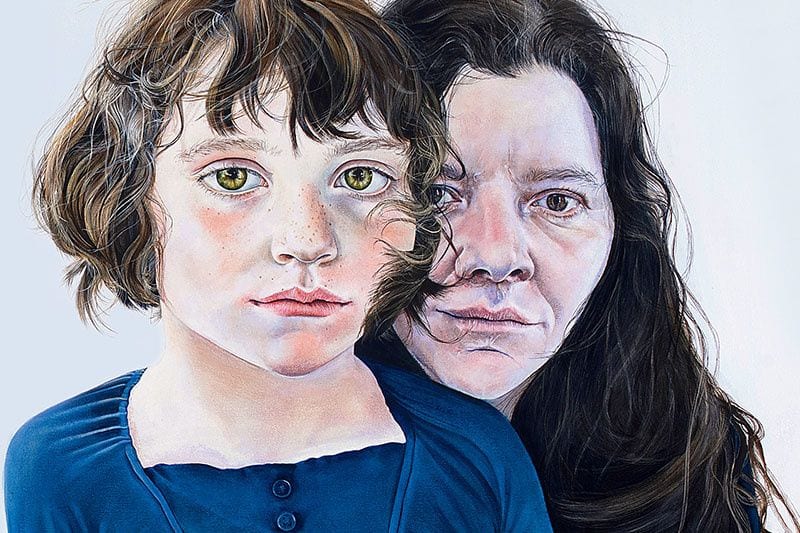
“My womanhood is intrinsic to my work” (11) says artist Anne Truitt, whose quote sets the context for Madam and Eve: Women Portraying Women. Authored by artist Liz Rideal and curator Kathleen Soriano, the collection explores the female artistic gaze as it sets on other women. The collection showcases various mediums ranging from oil painting, sculpture, photography, fashion, glass, or performance, to name just a few. Each artist is limited to a single piece, thereby allowing the authors to present a wide scope of work. Rideal and Soriano include both popular and lesser known artists. Yet Madam and Eve is unified by the inclusion of artists who have taken risks whether it is social, personal, or aesthetic. Rideal and Soriano curated a poignant examination of the impact feminist discourses have on contemporary art and the socio-cultural role of women artists.
Collecting the work of over 200 artists, the authors focus on pieces created since the ’70s. Specifically citing the ’70s feminist movement and the subsequent waves, the authors see social change as the collection’s discursive foundation. Madam and Eve aesthetically develops the discourses that frame women’s identities, emphasize body and sex positivity, and the connections made by global cultural shifts. Each work includes background information on the artist and jargon free analysis. This creates an engaging and accessible read made available to a wide audience.
Madam and Eve is organized into six distinct sections: “Historical Framework”, “Body”, “Life”, “Story”, “Death”, and “Icons”. The collection begins with a brief, and knowingly condensed, history of women’s art beginning around 1500. This section astutely considers various social positions of women and their triumph or negotiation of restrictive gender norms. Each artist and their work is described amongst their cultural background, providing readers with an informed viewpoint for critiquing their work. For example, the analysis for Charlotte Berend-Cornith’s Self-Portrait and Model reminds the readers of the power structure inherent in an artist/subject relationship. This is typically reaffirmed along gendered lines with the artist being male, while the subject denotes female and passivity. Berend-Cornith’s inclusion of the model and the artist as women “is a device that draws attention to both passive and active roles” (27). She also subverts the dominant narrative. “Historical Framework” deftly informs the reader of the contribution of women artists over the course of centuries. A narrative that has long been denied or minimized by androcentricity.
The “Life” section is awe-inspiring. The art forces the reader to witness authentic representations of women’s bodies. The photograph Julie, by Rineke Dijkstra,disrupts the misleading narratives which construct motherhood as pristine. The artwork features a semi-nude woman cradling a tiny newborn suggesting a variation of the Madonna and Child. Her only garment is a pair of hospital grade postpartum underwear. This image disassociates motherhood from purity. Similarly, Amalia Ulman’s work, Excellence and Perfection (#work #it #bitch) harkens modernity by the posting of her photographs “through Instagram and Facebook social media accounts.” (149). Captioning her images with a fictionalized autobiography, she included discussions of augmenting her body. The backlash was swift with followers and other artists decrying her embrace of the “vacuous and narcissistic concerns of contemporary culture” (149). Here Ulman successfully demonstrates the normalization of policing women and their bodies.
Madam and Eve takes a truly intersectional approach by including artists and subjects who define themselves as disabled, abuse survivors, women of color, and multi-generational. For example, the piece Oh! Susanna, by Ellen Gallagher, concentrates on the intersection of racial identity and gender. This piece in particular is a series of drawn eyes and mouths meant to evoke “the disembodied ephemera of minstrelsy” (216). While on the following page, artist Betye Saar rejects the legacy of racist imagery. The mix media assemblage, The Liberation of Aunt Jemima, subverts the typically objectionable image. Yet here she brandishes a broom, gun, and rifle symbolizing an act of protest. Aunt Jemima’s opposition to racist and sexist imagery is further evoked by the black power fists emblazoned on her skirt. The juxtaposition of these two pieces gives readers an overwhelming connection between radical social change and artistic innovation.
At times Madam and Eve unintentionally reads like an encyclopedia with each entry verging on formulaic. Throughout the book the interpretations are astute and accessible. Yet it would have added depth to the collection to cross-reference and make comparisons between works. The bordering of Oh! Susanna to The Liberation of Aunt Jemima serves as just one example. Clearly these pieces are intentionally situated next to each other. It would be interesting to read the author’s reasoning for the layout. However, it’s also interpretable that the authors omit this justification in order to force the reader to interact and critically engage with the collection. If that’s the case, it clearly works.
This review doesn’t even begin to describe the depth and magnitude of Madam and Eve. Together, the authors celebrate the wide spectrum of women artists and their significant contributions. It’s humbling to realize that the authors were judicious in their selection. There are millions of other artists creating equally honest and exciting documents of self-expression. That consideration only proves the need for texts such as Madam and Eve.
- Kathleen Soriano | Leading Culture Destinations
- Kathleen Soriano (@kathleen.soriano) • Instagram photos and videos
- A conversation with Kathleen Soriano | Ocula
- Kathleen Soriano - Curator, Royal Academy London - YouTube
- Liz Rideal – Liz Rideal
- Liz Rideal born 1954 | Tate
- Current | UK Friends of the National Museum of Women in the Arts
- Madam and Eve: Women Portraying Women

